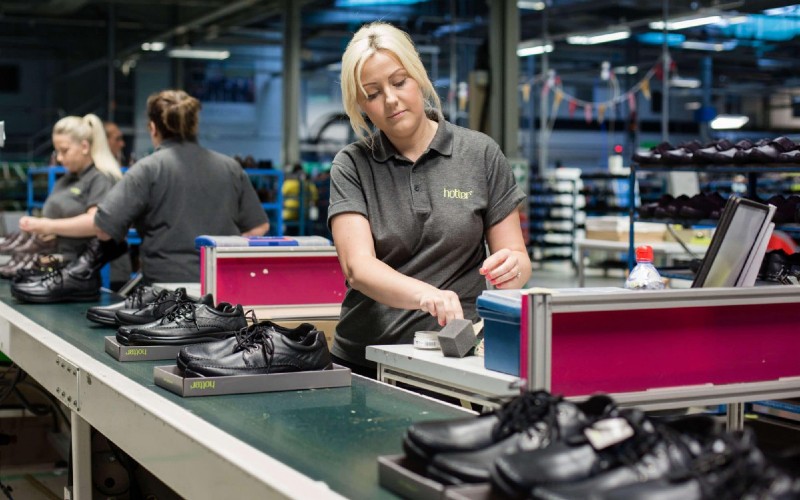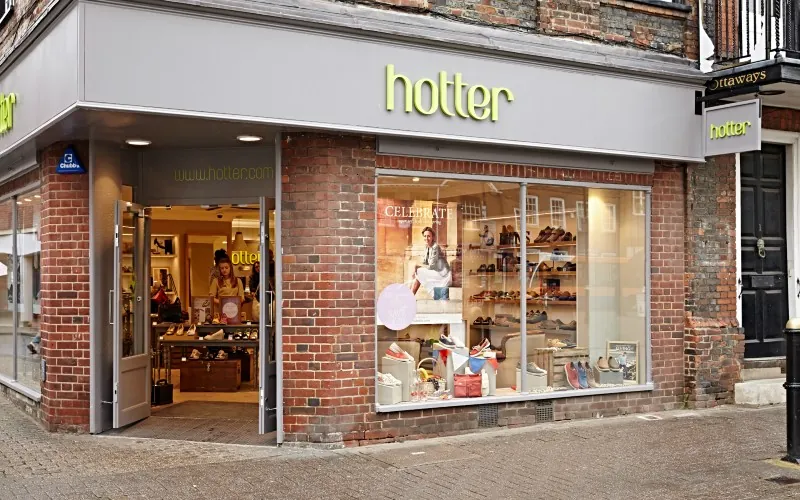To understand how far Hotter Shoes has fallen, I want to take you back to 2015 and a meeting I had with the company’s quality control coordinator Steven Stewart.
I only met Stewart for a few minutes but I’ll never forget our brief encounter. He’d lost three fingers after being treated for cancer when he was younger, but his passion for his job was infectious.
At the time Stewart had clocked up 46 years in the industry – the past 18 of which had been spent at Hotter – and he was passionate about his employer.
Beaconsfield Footwear, which trades as Hotter Shoes, had just been named Manufacturer of the Year at Insider’s Made in the UK Awards 2015, beating Rolls-Royce and Jaguar Land Rover in the process.
Manufacturer of the Year
It was on the back of that success that I found myself visiting their plant in Skelmersdale. It’s no exaggeration to say Stewart almost cried when I asked him what it meant to be named Manufacturer of the Year.
“I’m totally proud and passionate about making shoes for Hotter here in England,” he told me.
“We’ve got a fantastic team. When we won the Made in the UK Award for Manufacturer of the Year it was like winning a gold medal. It was the pinnacle of all my time in the footwear industry.”
It was some endorsement – but it was repeated by virtually every member of staff I spoke to.

By 2017 the company was proud to be the UK’s largest shoe manufacturer, employing 1,400 people and producing more than 2.2 million pairs of shoes per year at its factory in Lancashire.
Fast forward just six years and the spring had disappeared from Hotter’s step as the company lurched towards administration.
Yesterday it emerged the future of Hotter Shoes has at least been secured following its sale to the WoolOvers Group – saving the jobs of all 421 employees – but how did things go so disastrously wrong?
Origins
A global pandemic clearly didn’t help, but other retailers have survived – so what did Hotter Shoes do differently? To answer that, we need a quick recap by going back to 1959 and the origins of the business when Thomas and Harriet Houlgrave set up a company to make slippers.
However, the margins were tight and their son Stewart recognised that they were better off making their own brands than selling to third parties. Hotter Shoes was born.
During my visit in 2015 the chief executive was an impressive man called Peter Taylor, who’d been recruited in 2012 by Gresham, the owner at the time. Taylor wore an open-neck shirt and jeans for our interview and had created a relaxed atmosphere among his leadership team.
Gresham originally invested in Hotter in 2007 through a management buyout. Taylor was brought in with a remit to prepare the business for sale, and Electra Partners acquired the company in 2014 following an £85m investment.
In order to hit the growth the owners wanted, the company assembled an impressive senior management team, including Robert Perkins, who joined as operations director in 2014 after a 30-year career with the likes of Kukri, Pittards and Clarks.
Stewart Houlgrave had stepped back a little but remained on the board, and Taylor and Perkins credited him with transforming the business.
“When Stewart set up the Hotter brand in 1992 he started by selling the product to third-party independent footwear retailers in the UK,” explained Taylor at the time.
“He put an insert into a magazine and got such a good response that he created a mail order business.
“Then he decided to open a shop in Southport. Then he set up a website. By the time Gresham came in we were still predominantly a mail order business but with a fledgling web business and a miniscule retail business.”
Houlgrave remained passionate about developing the product while Taylor introduced more structure.
Tech investment
While other UK shoe manufacturers went to the wall, Hotter continued to flourish on the back of a major investment in technology and automation to make the company capital intensive rather than labour intensive.
During my 2015 site visit, Hotter’s four core values – brand, customers, comfort and people – were everywhere.
The staff wore their uniforms with pride and many had been with the company all their working lives. The business had its own 120-seat call centre to field calls from the UK and US markets.
In 2014 turnover was £96m with EBITDA of £12m and a stated goal of doubling in size.
Under Taylor’s watch, it opened 65 stores and employed more people at its stores (750) than it did at its Skelmersdale headquarters (500).

At the time the US market had achieved 40% growth while Hotter had recently signed a deal to open 10 stores in the Middle East.
Back in 2015 Taylor said the secret of their success was simple. “As customers you don’t have to compromise between comfort and style,” Taylor told me. “The brand is very down-to-earth, it’s honest, it’s fun. Our retention rate on customers is very high.”
I’ve visited a lot of businesses during my career but I can’t remember being as impressed by one as much as I was by Hotter Shoes – which is why their current travails are so shocking.
So what went wrong?
Key decisions
Taylor, whose LinkedIn profile says he’s ’enjoying life’, was succeeded as CEO in 2016 by Sara Prowse. She was well-liked and was replaced in 2019 by Ian Watson (pictured in main image). She is now the highly respected CEO of UA92.
What happened next can best be described as a perfect storm, with Covid-19 at its eye.
Hotter’s main shareholder, Electra Private Equity, appeared to change course on strategic goals for Hotter by not pressing ahead with its planned US growth plan and IT transformation.
Watson, whom I’ve never met, was a different type of leader to Prowse and moved the business model away from being store-led to eCommerce-led, which makes sense in a global pandemic.
According to the company, Hotter reported a 27% leap in online sales (year-on-year) in the last six weeks of 2020, as it tapped into the boom in online shopping.
Watson clearly knows his business better than me but industry experts have questioned two key decisions.
“Why did Hotter pursue a strategy of sourcing more shoes from overseas instead of making the shoes in its own world class factory, which only a few years ago won the title of Manufacturer of the Year and was the UK’s largest shoe factory?” asked one industry expert.
“Under Ian’s leadership, Hotter also chose to put significant resources into creating a marketplace website called Unbound to compete against Very, M&S, Next etc.”
Why did he do it? Supporters said it was a brave move, but critics said it was doomed to fail.
Senior members of staff have left. Perkins retired as COO in 2019 while his successor Vicky Woodman left earlier this year.
What’s not in dispute is the perilous state Hotter Shoes found itself in before its sale to WoolOvers Group by administrators.
In the days before that trading in Unbound – which listed on the London Stock Exchange in February 2022 – had been suspended after restructuring plans, including an equity fundraise, failed.
Despite the sale to WoolOvers Group the demise in fortunes at Hotter Shoes is an object lesson to the wider business community.


